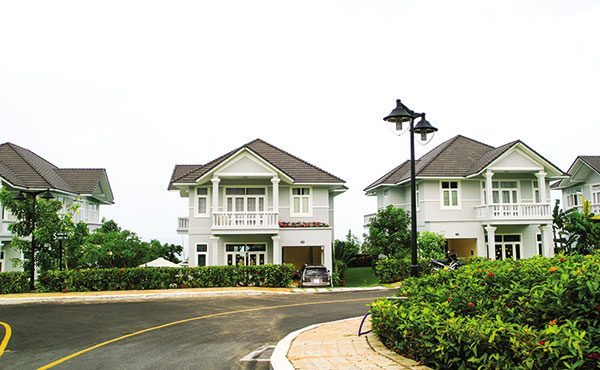Real estate bubble fear stirs up controversy
 |
| The property market still carries risk, though experts believe that there is no new property bubble in sight |
According to Vo Huynh Tuan Kiet, head of residential project marketing at CBRE Vietnam, the Vietnamese real estate market has experienced an unprecedented supply of new projects, with frequent launches and good net absorption.
“Along with the market’s traditional segments, new products have been introduced, such as second-home villas, condotels, and officetels. Since 2015, the Vietnamese government has loosened its requirements for foreigners buying and owning properties in Vietnam, which has helped attract more foreign investors to the market,” Kiet said.
Nonetheless, many experts and investors have cast doubts upon this rapid recovery, predicting underlying risks. These risks include an oversupply of high-end projects, the return of speculators, and falling market demand.
The biggest concern is the risk of another property bubble akin to the one that burst in 2007 and froze the property market until 2013. The market is still paying the price for this previous bubble.
“As the market in 2018 can expect more changes and uncertainties, we should be on the lookout for any worrying signs of a property bubble,” Kiet said.
A recent report on financial markets in 2017 released by the National Financial Supervision Commission stated that the market did not see much change in property prices last year.
Prices mainly increased in the segments of high-end and mid-range apartments. Prices rose by 3-10 per cent for some high-end apartment projects in urban areas with convenient locations, synchronous infrastructure, construction as per schedule, and reputable investors, as well as attractive sales and promotional policies.
The price of high-end apartments saw the greatest increase at 7-10 per cent, while prices rose 5-7 per cent for mid-range apartments and 3-5 per cent for affordable apartments.
In the domestic market in 2017, trading volume increased significantly compared to 2016, the report noted. The high-end and mid-range apartment segments witnessed the highest trading volume. The number of successful transactions was estimated to reach 68,000 units.
Meanwhile, the report said the real estate inventory of Vietnam was some VND25.7 trillion ($1.2 billion), a reduction of 17 per cent compared to December 2016.
In 2017, the credit flowing into real estate trading and construction activities decreased slightly, accounting for 15.8 per cent of total credit.
Observing the market in the period of 2015-2017, a notable number of high-end projects introduced by well-known developers have achieved good absorption rates.
This trend has caused concerns over a possible supply imbalance, which seems to lean toward the high-end segment during this period.
In 2017, however, the market adjusted to target the mid-range segment. The segment accounted for 58 per cent of new launches in Ho Chi Minh City and 62 per cent of new launches in Hanoi. It also accounted for 56 and 53 per cent of sold units in Ho Chi Minh City and Hanoi, respectively.
This adjustment helps to lessen concerns over the imbalance in favour of high-end products.
In previous years, due to substantial benefits from the trading of real estate, anyone could become a speculator. Nowadays, however, the trend has shifted toward end-users.
According to CBRE’s records, in the period of 2007-2008, 50 per cent of total transactions were made by short-term speculators.
“This drove housing prices out of control on the secondary market as houses were constantly ‘flipped’,” Kiet said.
In 2017, speculator transactions only accounted for 10-15 per cent of the market total and were mostly focused on certain areas.
The limited presence of speculation in recent years has helped to decrease the risk of escalating price growth.
Le Hoang Chau, chairman of the Ho Chi Minh City Real Estate Association, said there would be a raft of mergers and acquisitions this year, boosting construction activities in the city.
“There is no threat of a bubble this year thanks to timely action by the government. Furthermore, developers too have made efforts to tweak their investment so that they develop products that match the actual demand in the market,” Chau said.
Chau stressed that there would not be a bubble in 2018, based on the timely and suitable adjustments made by all related parties, from the government to developers and buyers.
Ngo Quang Phuc, deputy general director of Him Lam Land, said that the market in 2018 will see tough competition because of the increase of both enterprises and projects. “However, all of the supply now is adjusted toward the real demand of end-users, which means we do not have to worry about a bubble in the future,” Phuc said.
What the stars mean:
★ Poor ★ ★ Promising ★★★ Good ★★★★ Very good ★★★★★ Exceptional
Latest News
More News
- Sun Group breaks ground on $2 billion Van Don casino complex (December 19, 2025 | 18:14)
- Rare, beautiful, sustainable: the mark of iconic real estate (December 19, 2025 | 08:00)
- Owner-occupied housing stabilises, paving the way for new growth cycle (December 18, 2025 | 17:04)
- Unlocking urban potential of smart cities (December 18, 2025 | 16:50)
- Green finance offers 'passport' for Vietnamese construction, building materials firms (December 15, 2025 | 08:00)
- Gamuda Land commit long-term investment (December 12, 2025 | 11:49)
- HITC ties up with Evolution to develop AI and hyperscale data centres in Vietnam (December 11, 2025 | 12:09)
- Real estate deals boom via high-profile names (December 08, 2025 | 11:32)
- Industrial segment shaped by M&As (December 08, 2025 | 08:00)
- The Privé sets the benchmark for luxury real estate (December 05, 2025 | 08:28)

















 Mobile Version
Mobile Version